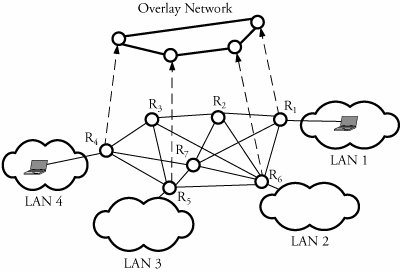Section 16.3. Overlay Networks
16.3. Overlay NetworksAn overlay network is an application-specific computer network built on top of another network. In other words, an overlay network creates a virtual topology on top of the physical topology. This type of network is created to protect the existing network structure from new protocols whose testing phases require Internet use. Such networks protect packets under test while isolating them from the main networking infrastructure in a test bed. Figure 16.11 shows an overlay network configured over a wide area network. Nodes in an overlay network can be thought of as being connected by logical links. In Figure 16.11, for example, routers R 4 , R 5 , R 6 , and R 1 are participating in creating an overlay network where the interconnection links are realized as overlay logical links. Such a logical link corresponds to a path in the underlying network. An obvious example of these networks is the peer-to-peer network , which runs on top of the Internet. Overlay networks have no control over how packets are routed in the underlying network between a pair of overlay source/destination nodes. However, these networks can control a sequence of overlay nodes through a message-passing function before reaching the destination. Figure 16.11. An overlay network for connections between two LANs associated with routers R 1 and R 4 For various reasons, an overlay network might be needed in a communication system. An overlay network permits routing messages to destinations when the IP address is not known in advance. Sometimes, an overlay network is proposed as a method to improve Internet routing as implemented in order to achieve higher-quality streaming media. Sometimes, for the implementation of such techniques as DiffServ and IP multicast, modification of all routers in the network is required. In such cases, an overlay network can be deployed on end hosts running the overlay protocol software, without cooperation from Internet service providers. Overlay networks are self-organized . When a node fails, the overlay network algorithm should provide solutions that let the network recover and recreate an appropriate network structure. Another fundamental difference between an overlay network and an unstructured network is that overlays' look-up routing information is on the basis of identifiers derived from the content of moving frames . 16.3.1. Peer-to-Peer (P2P) ConnectionAs an overlay network resembles a system consisting of various applications running on a single operating system, it could also resemble a set of tunnels that interconnect resources and users. The interconnects are carried out by peer-to-peer (P2P) protocols. Let be the time required to establish a connection and t f be the time to finish the service as soon as the connection establishes. Assuming that the requests arrive at random to a peer node, the service time s is Equation 16.1 When a request arrives, the peer can be connected with probability p c and not connected with probability 1 - p c . Realizing that s is a continuous random variable (see Appendix C) and is discrete for its two cases, discussed in Equation (16.1), the expected value of average service time is derived by Equation 16.2 Let Equation 16.3 Similarly, the fraction 1 - that the same mentioned given time is idle can be derived by Equation 16.4 where the idle time occurs when the peer is either disconnected or connected but not using the connection. We can now derive an expression for the peer connection efficiency, u , as follows : Equation 16.5 The connection efficiency of the peer can be used to determine the overall efficiency of the P2P connection. |
EAN: 2147483647
Pages: 211
- Integration Strategies and Tactics for Information Technology Governance
- An Emerging Strategy for E-Business IT Governance
- Linking the IT Balanced Scorecard to the Business Objectives at a Major Canadian Financial Group
- Measuring and Managing E-Business Initiatives Through the Balanced Scorecard
- Governance Structures for IT in the Health Care Industry
